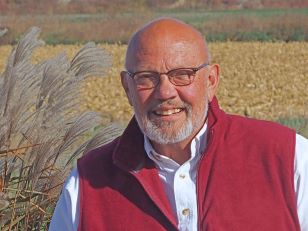
Out in the middle of nowhere, the old white frame building is all that remains of a heart-felt dream that, as an answer to prayer, opened its doors in 1893 to frontier kids who wanted the kind of education not otherwise available in the Dakota Territories before the turn of the century.
A monument stands proudly out front, a tribute to the dreamer, the Rev. Mr. Lewis E. Camfield, a relative of Ralph Waldo Emerson actually, fellow abolitionist, and almost as much a transcendental visionary. The Reverend Camfield put legs beneath that vision and determined he’d make a Christian education available to pioneer kids who, with their hopeful families, were still streaming into the open country, ex-reservation land, all around.
One day in 1892, Camfield and a friend were out among the sodbusters of Charles Mix County, collecting donations for the education of black children in the American South. At the end of the day, when they tallied the purse, they were amazed–they had twenty dollars. They were thrilled.
That’s when they came up with the idea: if a hundred dirt-poor farmers and would-be ranchers could cough up that kind of money for needy kids a thousand miles away, shouldn’t it be possible to create a preparatory school that would serve their own children right here?
So the Reverend Mr. Camfield said he’d try, and just a year later, Ward Academy opened its doors to 23 students. In a few years, the place had admirable facilities and close to 150 students. Tuition—nine months’ worth—was nothing to sneeze at–$100. Most kids worked on the grounds and the farm the school created to pay off that daunting bill.

In 1911, when the enrollment hit an all-time high of 148 students, Warren Hall was built, an edifice three stories high—and a basement–that cost in total $20,000. Be sure, Warren Hall was, “commodius,” or so the Reverend Camfield himself described it. All the modern conveniences–a common dining hall, an assembly room, an office, and two dormitories—one for women, the other for teachers.
The broad prairie around Academy, Charles Mix County, South Dakota, is so flat and wide people like to say you can watch your dog run away for three days in any single direction. Amid that kind of land, try to imagine sky-scraping Warren Hall, a three-story monster, tall and formidable as a battleship, a fortress for Christian education amid eternal land and sky.
For a time, Ward Academy, on the Great Plains of South Dakota, must have seemed, in its hustle and bustle, a purposefully clear and direct answer to L. E. Canfield’s fervent prayer: it was “velvet in a rugged new land of burlap green,” one old local history calls it, way out there, 27 miles from the nearest railroad.
Today, what’s left is a one old building with that sits up on a knoll as if still proclaiming the importance of higher education. Ward Academy hasn’t seen a student in years. Thirty-nine years after its energetic birth, Ward Academy shut its doors. It was 1931—the DustBbowl, the Depression, end of story.

Today, out front, a wide stone memorial commends and memorializes the diligence, the vision, and the commitment of the Camfields: “To the memory of Dr. Lewis E. and Ella Woodman Camfield, founders of Ward Academy at this site in 1893, [who] dedicated their lives to the building of Christian character through church and school.”
The school is gone, but what’s left is a church, not a mega.
Still, all of this is more than a little daunting to someone like me, who has spent most of his adult years at yet another small educational institution not all that far east. I’ve stopped at Academy every so often in the last decade or so to pay respects. To me, something about the place is richly haunted.
Ward Academy came to mind this week when my friend Brian Keepers, who lives just up the road, offered his own heartfelt contribution in these very pages. Academy came to mind specifically in that striking Romero quote: “We are prophets of a future not our own.”
For the record, Brian, I thought I’d pass along the story because just a week ago I stopped again at what was once so long-ago Ward Academy. I wanted to get another picture of that noble monument out front.
I did, and when I drove around the building, this is what I found.

Somebody’s working there. Prophets of a sort, I suppose, as are we all.
Sweet, huh? Just thought I’d let you know.

